
mainstreetlawn
10 Pro Tips Laying a Stepping Stone Path
A stepping stone path could simply be dropping flagstone on the ground or it could also be an intricate paver or stone walkway.
In this article, we offer 10 pro tips for laying a stepping stone path that will help you to prepare and plan for a successful stone installation.
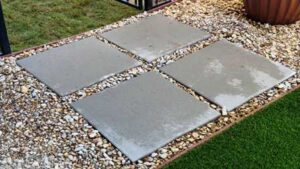
What should the distance between stepping stones be?
One of the first things to consider before installing the stones for a stepping path is the distance between the stones. You need to find the distance that is natural for you as you navigate from one step to the other. To determine this distance, walk naturally and measure the distance between the middle of one foot to the other. This is the distance you should have between each stepping stone.
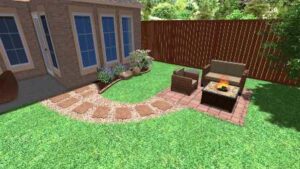
Can you lay stepping stones on soil?
Yes you can lay stepping stones directly on soil. Keep in mind that soil can erode and sink over time. If this is likely to create a problem in your landscaping installation area, consider using an aggregate like decomposed granite or sand under the stepping stones to create a more solid level surface.
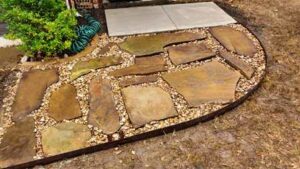
What do you put under stepping stones?
In order for your stepping stones to be stable, they should be laid on compacted soil, a fine aggregate such as decomposed granite and cushioning sand for leveling.
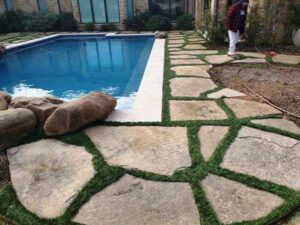
What to put between stepping stones?
If you are installing individual stones for each step, the area between steps can be made up of decomposed granite, rock, or even filled in with groundcover plants or sod.
If the stones for your pathway are being installed next to each other to create a pattern, smaller rocks or fine aggregate can be placed in between the stones.
For tight-fitting applications such as a paver or travertine stone pathway, we recommend you broom sand or polymeric sand between the joints to prevent shifting.
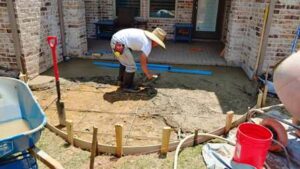
How do you level uneven ground?
To create of more level installation area, you can back fill with soil, rake and compact it. For larger stepping stone pathways in need of a more level stable surface, install an aggregate such as decomposed granite and compact.
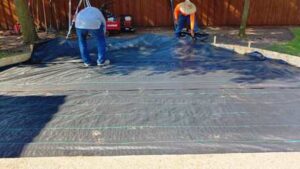
Should I put landscape fabric under pavers?
Yes. You should always install a landscape fabric barrier below a paver installation. The landscape fabric creates a barrier to prevent weed and grass growth between the paver stones and helps to reduce erosion.
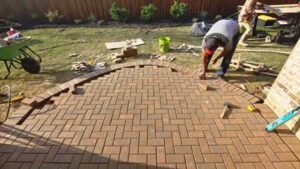
How do I stop my pavers from sinking?
Because paver pathways will sit on top of soil, there is always a chance that soil erosion and settling will lead to your installed patio pavers sinking. To prevent sinking, you must prepare a solid base for the pavers to sit on with good drainage qualities or install a drainage system. This solid base can be achieved by installing a 4 inch base of compacted aggregate or concrete.
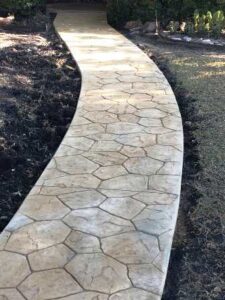
How wide should a walkway be?
Your walkway should be as wide as it needs to be to comfortably navigate. On average, most walkways or pathways are between 3 feet and 4 feet wide.
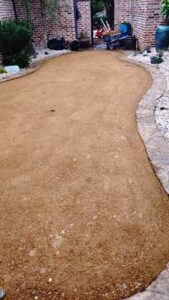
What is the cheapest walkway material?
The cheapest walkway aggregate material is decomposed granite. Decomposed granite is a fine aggregate that can be compacted and hardened to stabilize for foot traffic.
The least expensive walkway stepping stone material would be gray concrete patio stone.
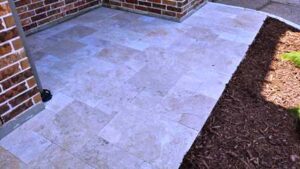
What is the best material for a walkway?
The best material for a walkway would be travertine or concrete pavers. Both the natural travertine and concrete pavers are more thick and dense than gray concrete patio stone so they provide excellent durability.
In summary, consider first the type of pathway you would like, simply stepping stones or an intricate walkway. Take your time to create a level stable surface and select materials that will last. Consider hiring a masonry contractor if you choose to install an intricate walkway or are unable to shovel and lift heavy stones and aggregate.
Share this post
© 2024 · Main Street Lawn Care and Landscaping, LLC

